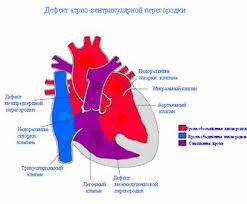
The proper development of the Atrioventricular canal into its prospective components (The heart septum and associated valves) to create a clear division between the four compartments of the heart and ensure proper blood movement through the heart, are essential for proper heart function. When this process does not happen correctly, a child will develop atrioventricular canal defect which occurs in 2 out of every 10,000 births. It also has a correlation with Down Syndrome because 20% of children with Down Syndrome suffer from atrioventricular canal disease as well. This is a very serious condition and surgery is necessary within the first six months of life for a child. Half of the children who are untreated with this condition die during their first year due to heart failure of pneumonia.
Atrioventricular canal defect is a combination of abnormalities of the heart and is present at birth. There is a problem when there are holes present in the walls that separate chambers (septum), as well as when valves are incorrectly constructed. There are other names for these heart abnormalities such as endocardial cushion defects or atrioventricular septal defect.
Development of atrioventricular canal disorder
This defect is developed because of the improper formation of the endocardial cushions, and their job is to separate the different parts of the heart during development when they fuse. The structures that develop from the fusion of the endocardial cushions are:
Atrial septum- this structure divides the left and right atrium
Ventricular septum-this structure divides the left and right ventricles.
Mitral Valve and tricuspid valve - these valves are formed by the proper division of an early common valve being separated into two.
Types of atrioventricular canal disorder
There are two types of atrioventricular canal disorder:
partial AVCD- includes openings between the left and right atria and improper formation of the mitral valve.
complete AVCD- there is free movement in all chambers because there is a large hole where the atria and ventricles meet, and instead of there being two valves there is one common valve.
Risk Factors
Down syndrome is often associated with AVCD, Having a parent with a congenital heart defect, alcohol use while pregnant, uncontrolled diabetes treatment during pregnancy and some medications during pregnancy.
A study also showed that there is also an increased risk of atrioventricular canal in patients who suffer from Noonan syndrome. The pattern seen in those patients with Noonan syndrome differ from those patients who have Down syndrome in that "partial" AVCD is more prevalent in those who suffer from NS, where as those who suffer from down syndrome show a prevalence of the "complete" form of AVCD.
Effects of atrioventricular canal disorder
Complications
When there are holes in the septum that divide the four chambers of the heart the oxygen-rich blood and oxygen-poor blood mix this creates more stress on the heart to pump blood to where oxygen is needed. As a result, you get enlargement of the heart, heart failure (being unable to adequately supply body with needed oxygen, pulmonary hypertension, and pneumonia. [3]
The development of pulmonary hypertension is very serious. And this because the left ventricle is weakened due to its overuse. When this happens, the pressure backs up into the pulmonary veins and the lungs. This type of damage is irreversible which is why immediate treatment is recommended after diagnosis.
Symptoms
Symptoms include difficulty breathing (dyspnea) and bluish discoloration on skin and lips (cyanosis). A newborn baby will show signs of heart failure such as edema, fatigue, wheezing, sweating and irregular heartbeat
Treatment
Surgery is usually conducted in-between the 3rd and 6th month of life, and with this condition the earlier the better. Usually, intracardiac repair is completed which is when they close the holes in the septum and they make two new atrioventricular valves that is available from the underdeveloped common valve leaflet.

